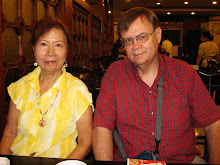 The leaves are very light with alternating green and almost yellow leaves. When I write that the leaves are light, I mean very thin and very delicate looking. The 100 grams of tea we bought is quite a bit of tea. It takes a lot of these leaves to make up a single gram. This is nothing like the green tea from Emei.
The leaves are very light with alternating green and almost yellow leaves. When I write that the leaves are light, I mean very thin and very delicate looking. The 100 grams of tea we bought is quite a bit of tea. It takes a lot of these leaves to make up a single gram. This is nothing like the green tea from Emei. Close up you can see the light yellow with a lot of white hair along the sides of each leaf.
Close up you can see the light yellow with a lot of white hair along the sides of each leaf. Here is what the internet says about this tea:
MengDing Gan Lu tea is a famous mountain tea in China, belonging to tender green tea classification. The rainy season there is as long as nine months each yearand the temperature is relatively cool on the slope of the mountain. This environment is ideal for this mountain tea.
As early as in the western Han Dynasty (202 BC - 24 AD), a farmer named Wu Li Zhen discovered a special tea species amid the foggy peaks on Mount MengDing. He is believed to be the founder of the MengDing tea gardens.
During the Tang Dynasty, the best tea gardens were assigned to be royal gardens. Every year around the Qing Ming Festival (April 5), the local governor would be dress in ceremonial attires, offering sacrifices to gods, and asked the Buddhist priests
to worship the tea trees, then picked up 365 pieces of tea leaves. When processing the leaves, the Buddhist monks would continue with their prayers. These 365 tea leaves would be called the "holy tea" and reserved in two silver bottles. The tea would be used in the Emperor's sacrificial ceremony to his family's ancestors. The local officers would also pick some other leaves, process them to the tea product, then reserve the tea in another 18 tin bottles, which was called "ordinary tea" or "secondary tea" for the royal family's daily life.
This traditional was maintained from the Tang Dynasty (618-906 AD) to the Qing Dynasty (1644-1911 AD) for more than a thousand years. (http://tea.timzhao.com/CTCOM/product/mengding.htm)
 The first cups from the Gan Lu tea show a pale yellowish to golden color. The tea is light, offering a sweet first taste, with a smooth and refreshing sensation as it moves from tongue to throat. There seems to be a slightly sweet aftertaste, extremely pleasant. As I drank this Gan Lu tea, I tasted or experienced absolutely no astringency even when I let the tea steep a few minutes extra on the third infusion.
The first cups from the Gan Lu tea show a pale yellowish to golden color. The tea is light, offering a sweet first taste, with a smooth and refreshing sensation as it moves from tongue to throat. There seems to be a slightly sweet aftertaste, extremely pleasant. As I drank this Gan Lu tea, I tasted or experienced absolutely no astringency even when I let the tea steep a few minutes extra on the third infusion. Who would not like this tea? It is subtle and mild and energizes one's senses quite a bit. Unlike the puerh I drink, I felt no numbing sensation on my cheeks. I did, however, experience an awaking of my spirit as I drank my fourth and fifth cups. This is as good as advertised! What a pleasant tea!
The only thing I might have done incorrectly is not put enough leaves in my little teapot. Even with more leaves, I cannot imagine the tea changing much in taste and performance. It simply appeared that the leaves had not filled up the pot as I had expected they would.
 Here are the expended Gan Lu leaves. As you can see, they are truly small and picked very young. The green color is pretty consistent on each one and each stem looks to have a bud and two leaves. A very wonderful experience I had with this tea. We definitely will add this tea to our MUST HAVE list.
Here are the expended Gan Lu leaves. As you can see, they are truly small and picked very young. The green color is pretty consistent on each one and each stem looks to have a bud and two leaves. A very wonderful experience I had with this tea. We definitely will add this tea to our MUST HAVE list.


1 comment:
My wife and I have so much fun when we travel and find anything... like stray cats and squirrels.
Flights to Gaborone
Cheap Flights to Gaborone
Cheap Air Tickets to Gaborone
Post a Comment